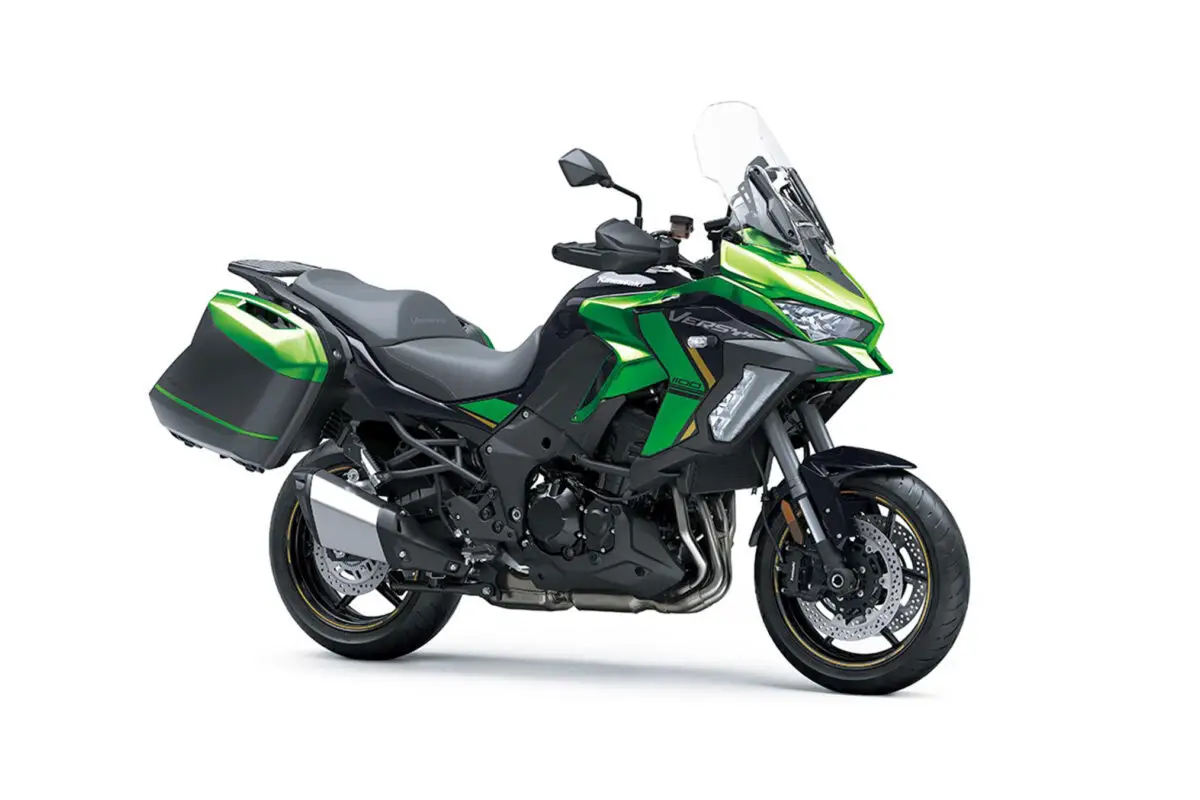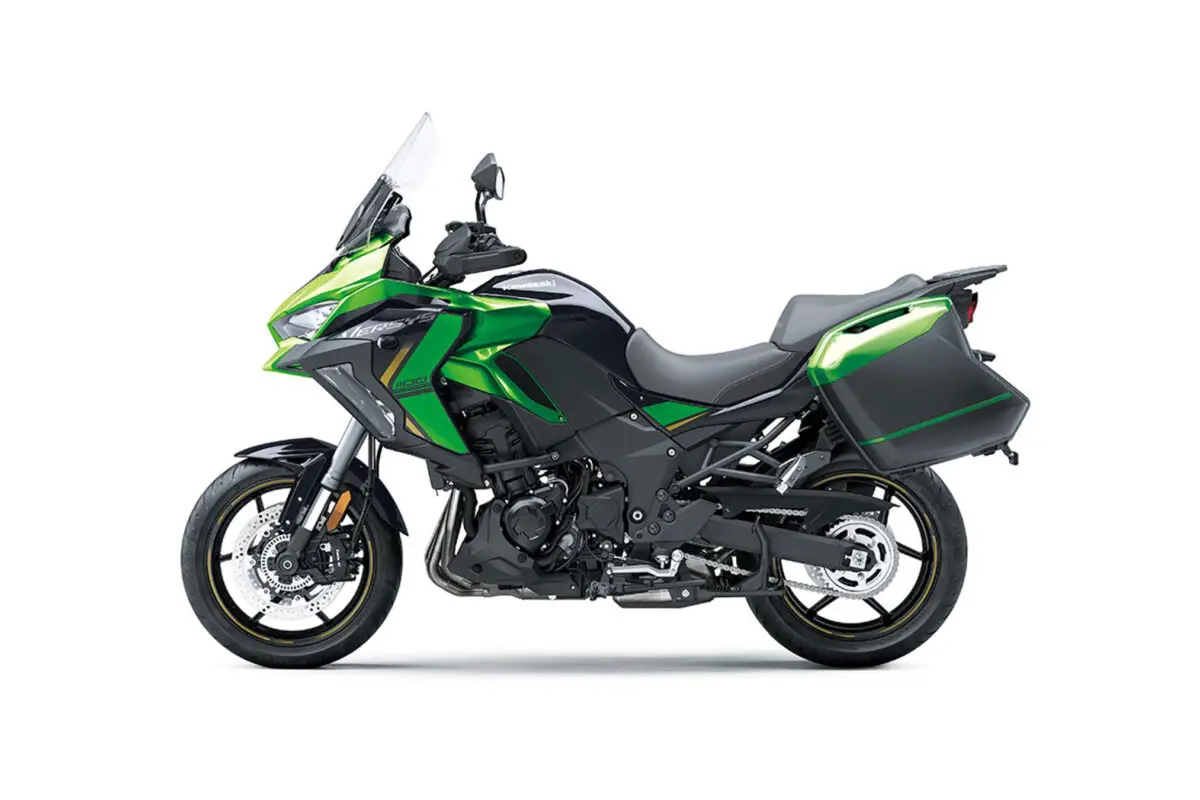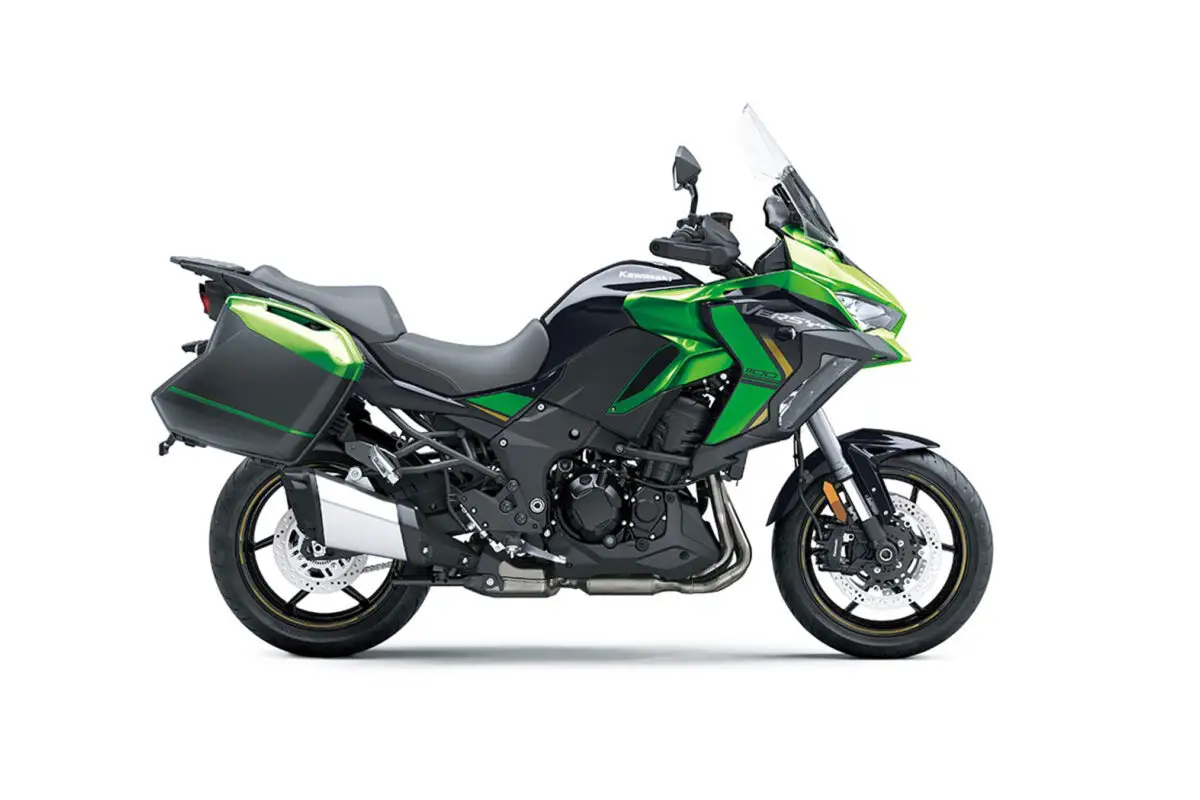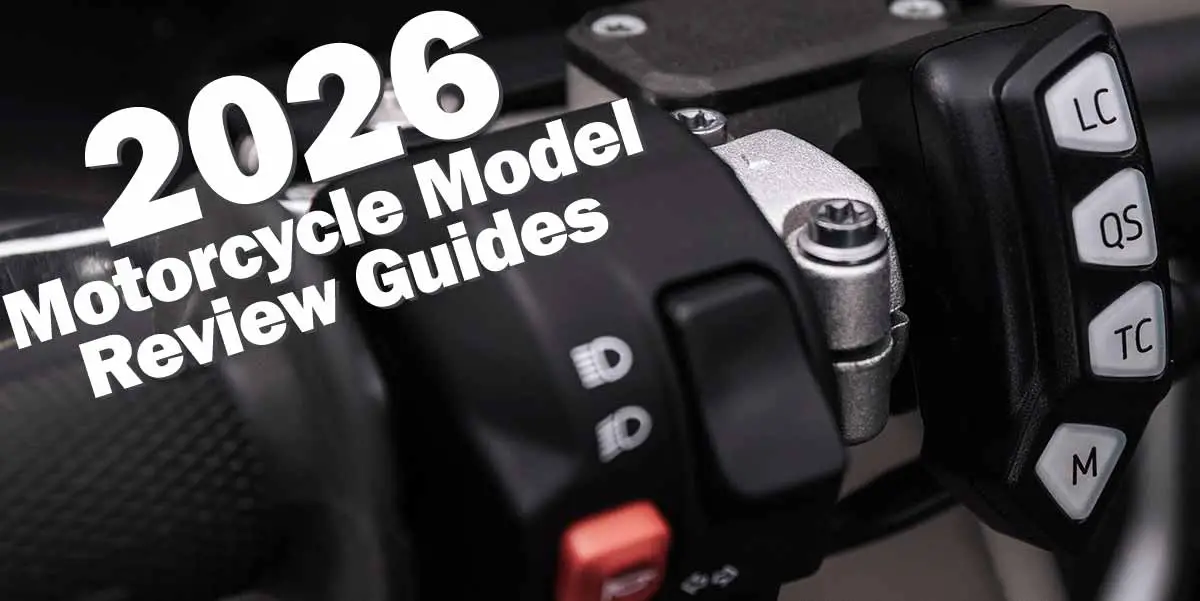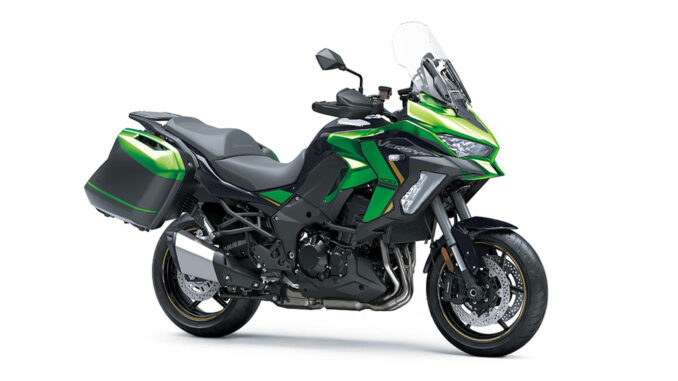
Kawasaki’s fully electronic throttle actuation system enables the ECU to control the volume of both the fuel (via fuel injectors) and the air (via throttle valves) delivered to the engine. Ideal fuel injection and throttle valve position results in smooth, natural engine response and the ideal engine output. The system also makes a significant contribution to reduced emissions.
Review – Key Features – Features & Benefits – Specifications
2026 Kawasaki Versys 1100 SE LT ABS: BIG ADVENTURES AWAIT.
Introducing the 2026 Kawasaki Versys 1100 SE LT ABS…
SPORT TOURING PERFORMANCE FOR COMFORTABLE COMMUTES AND LONG-RANGE ADVENTURES
2026 Kawasaki Versys 1100 SE LT ABS Totalmotorcycle.com Key Features
KAWASAKI ANNOUNCES FALL RELEASE OF 2026 STREET MOTORCYCLES
No matter what type of motorcycle you’re looking for, Kawasaki’s 2026 lineup has the model for you as it welcomes the return of several naked, retro, touring, adventure, cruiser, and EV models to its street motorcycle lineup. These 2026 model-year motorcycles are set to arrive in Kawasaki dealerships during the fall months so that riders can continue to “Let the Good Times Roll.”
2026 Kawasaki Versys 1100 SE LT ABS Totalmotorcycle.com Features and Benefits
TECHNOLOGY
ENGINE MANAGEMENT TECHNOLOGY
Assist & Slipper Clutch
Based on feedback from racing activities, the Assist & Slipper Clutch uses two types of cams (an assist cam and a slipper cam) to either drive the clutch hub and operating plate together or apart.
Under normal operation, the assist cam functions as a self-servo mechanism, pulling the clutch hub and operating plate together to compress the clutch plates. This allows the total clutch spring load to be reduced, resulting in a lighter clutch lever feel when operating the clutch.
When excessive engine braking occurs – as a result of quick downshifts (or an accidental downshift) – the slipper cam comes into play, forcing the clutch hub and operating plate apart. This relieves pressure on the clutch plates to reduce back-torque and helps prevent the rear tire from hopping and skidding. This race-style function is particularly useful when sport or track riding.
Economical Riding Indicator
Using high-precision electronic control for engine management, Kawasaki models can achieve a high level of fuel efficiency. However, fuel consumption is greatly affected by throttle use, gear selection, and other elements under the rider’s control. The Economical Riding Indicator is a function that indicates when current riding conditions are consuming a low amount of fuel. The system continuously monitors fuel consumption, regardless of vehicle speed, engine speed, throttle position and other riding conditions. When fuel consumption is low for a given speed (i.e. fuel efficiency is high), an “ECO” mark appears on the instrument panel’s LCD screen. By riding so that the “ECO” mark remains on, fuel consumption can be reduced.
While effective vehicle speed and engine speed may vary by model, paying attention to conditions that cause the “ECO” mark to appear can help riders improve their fuel efficiency – a handy way to increase cruising range. Further, keeping fuel consumption low also helps minimize negative impact on the environment.
Electronic Throttle Valves
Kawasaki’s fully electronic throttle actuation system enables the ECU to control the volume of both the fuel (via fuel injectors) and the air (via throttle valves) delivered to the engine. Ideal fuel injection and throttle valve position results in smooth, natural engine response and the ideal engine output. The system also makes a significant contribution to reduced emissions.
Electronic throttle valves also enable more precise control of electronic engine management systems like S-KTRC and KTRC, and allow the implementation of electronic systems like KLCM, Kawasaki Engine Brake Control, and Electronic Cruise Control.
Electronic Cruise Control
Electronic Cruise Control allows a desired speed (engine rpm) to be maintained with the simple press of a button. Once activated, the rider does not have to constantly apply the throttle. This reduces stress on the right hand when traveling long distances, enabling relaxed cruising and contributing to a high level of riding comfort.
KCMF (Kawasaki Cornering Management Function)
Using the latest evolution of Kawasaki’s advanced modeling software and feedback from a compact IMU (Inertial Measurement Unit) that gives an even clearer real-time picture of chassis orientation, KCMF monitors engine and chassis parameters throughout the corner – from entry, through the apex, to corner exit – modulating brake force and engine power to facilitate smooth transition from acceleration to braking and back again, and to assist riders in tracing their intended line through the corner. The systems that KCMF oversees vary by model, but may include:
– S-KTRC/KTRC (including traction management and wheel lift management)
– KLCM (including traction management and wheel lift management)
– Designed to optimize acceleration from a stop
– KIBS (including pitching management and corner braking management)
– Kawasaki Engine Brake Control
KQS (Kawasaki Quick Shifter)
Designed to help riders maximize their acceleration on the track by enabling clutchless upshifts with the throttle wide open, KQS detects that the shift lever has been actuated and sends a signal to the ECU to cut ignition so that the next gear can be engaged without having to use the clutch. On models that offer clutchless downshifts, during deceleration the system automatically controls engine speed so that the next lower gear can be selected without operating the clutch.
KTRC (Kawasaki Traction Control)
KTRC, Kawasaki’s advanced traction control system provides both enhanced sport riding performance and the peace of mind to negotiate slippery surfaces with confidence. Multiple rider-selectable modes (the number of modes varies by model) offer progressively greater levels of intrusion to suit the riding situation and rider preference.
Less intrusive modes maintain optimum traction during cornering. Designed with sport riding in mind, they facilitate acceleration out of corners by maximizing forward drive from the rear wheel. And because Kawasaki’s sophisticated software bases its dynamic analysis on the chassis’ orientation relative to the track surface (rather than relative to a horizontal plane), it is able to take into account corner camber, gradient, etc., and adapt accordingly.
In the more intrusive modes (and for some models, in any mode), when excessive wheel spin is detected, engine output is reduced to allow grip to be regained, effectively enabling riders to negotiate both short, slippery patches (train tracks or manhole covers) and extended stretches of bad roads (wet pavement, cobblestone, gravel) with confidence.
Models equipped with IMU incorporate chassis-orientation feedback to offer even more precise management.
Power Modes
Models equipped with multiple Power Modes offer riders an easily selectable choice of engine power delivery to suit riding conditions or preference. In addition to Full Power mode, one (Low) or two (Middle, Low) alternate mode(s) in which maximum power is limited and throttle response is milder are provided.
Smartphone Connectivity
Clever technology enables riders to connect to their motorcycle wirelessly. Using the smartphone application “RIDEOLOGY THE APP,” a number of instrument functions can be accessed, contributing to an enhanced motorcycling experience. Vehicle information (such as the odometer, fuel gauge, maintenance schedule, etc) can be viewed on the smartphone. Riding logs (varies by model, but may include GPS route, gear position, rpm, and other information) can be viewed on the smartphone. When connected, telephone (call, mail) notices are displayed on the instrument panel. Riders can also make changes to their motorcycle’s instrument display settings (preferred units, clock and date setting, etc) via the smartphone. And on certain models, it is even possible to check and adjust vehicle settings (such as Rider Mode, electronic rider support features, and payload settings) using the smartphone.
CHASSIS MANAGEMENT TECHNOLOGY
ABS (Anti-lock Brake System)
Kawasaki ABS systems use front and rear wheel sensors to constantly monitor wheel speed. Should information from either of the sensors indicate that wheel lock has occurred, the ABS ECU directs the pump in the ABS unit to modulate brake fluid pressure (releasing and reapplying pressure so that traction can be regained) until normal operation resumes. ABS offers rider reassurance that contributes to greater riding enjoyment.
Cornering Lights
A set of three LED lights built into each side of the fairing (on certain models) are illuminated based on lean angle. They help illuminate the road when cornering at night. Each of the three lights has a fixed direction, and the lights come on based on the lean angle.
Horizontal Back-link Rear Suspension
Compared to the Kawasaki traditional Uni-Trak rear suspension, which mounts the shock unit vertically, with Horizontal Back-link Rear Suspension, the shock unit is almost horizontal. The original Kawasaki suspension arrangement locates the shock unit very close to the bike’s center of gravity, greatly contributing to mass centralization. And because the shock is placed horizontally, it is much further away from the exhaust pipes, heat transfer from the exhaust system to the shock is less. Also, located above the swingarm, the shock’s upper mount does not need to be attached to the frame, contributing to lighter frame construction. Lastly, because there is no linkage or shock unit protruding beneath the swingarm, this frees up space for a larger exhaust pre-chamber (an exhaust expansion chamber situated just upstream of the silencer). With a larger pre-chamber, silencer volume can be reduced, and heavy exhaust components can be concentrated closer to the bike’s center of gravity, further contributing to mass centralization. The result is greatly improved handling.
Another benefit is that the shock unit is placed far away from exhaust heat. Because it is more difficult for exhaust heat to adversely affect suspension oil and gas pressure, suspension performance is more consistent. Horizontal Back-link Rear Suspension offers numerous secondary benefits like this.
IMU-Enhanced Chassis Orientation Awareness
Combined with Kawasaki’s proprietary dynamic modeling program, input from the IMU (Inertial Measurement Unit) enables even more precise chassis orientation awareness, the key to bringing Kawasaki’s electronics to the next level.
KECS (Kawasaki Electronic Control Suspension)
KECS adapts to road and riding conditions in real time, providing the ideal amount of damping required. Combining high-level mechanical components with the latest electronic control technology, KECS offers both the suppleness to handle a wide range of street riding situations, as well as the firm damping to facilitate more sporty riding. The addition of electronic adjustment of preload (on some models) and Showa’s Skyhook technology (on some models) offer a more complete package.
KIBS (Kawasaki Intelligent anti-lock Brake System)
Kawasaki developed KIBS to take into account the particular handling characteristics of supersport motorcycles, ensuring highly efficient braking with minimal intrusion during sport riding. It is the first mass-production brake system to link the ABS ECU (Electronic Control Unit) and engine ECU.
In addition to front and rear wheel speed, KIBS monitors front brake caliper hydraulic pressure, throttle position, engine speed, clutch actuation and gear position. This diverse information is analyzed to determine the ideal front brake hydraulic pressure. Through precise control, hydraulic pressure is modulated in much smaller increments than with standard ABS systems. The system limits rear wheel lift under heavy braking and takes downshifting into account while braking, allowing the rider to manage the rear brake. And because of the finer control, kickback to the brake lever is minimal, resulting in a very natural feeling.
ERGONOMICS
ERGO-FIT
Proper fit is key for rider comfort and control. However, the ideal fit varies from rider to rider, depending on their physical dimensions and riding style.
ERGO-FIT is an interface system designed to allow riders to find their ideal riding position. Various points of the chassis interface (handlebar, footpegs and seat, etc.) can be adjusted through a combination of interchangeable parts and parts with adjustable positions. This enables a wide range of riders to find a riding position that offers both comfort and control.
Feeling at one with their machine, they will be able to experience how Kawasaki machines are fun and rewarding to ride.
*Accessory parts may be required. Consult your local dealer.
2026 Kawasaki Versys 1100 SE LT ABS – Totalmotorcycle.com USA Specifications/Technical Details
US MSRP Price: $NA USD
Canada MSRP Price: $ 20999 CDN
Europe/UK MSRP Price: £ NA (On The Road inc 20% Vat)
TBA
2026 Kawasaki Versys 1100 SE LT ABS – Totalmotorcycle.com Canadian Specifications/Technical Details
POWER
| Power | 99 kW {135 PS} / 9,000 rpm |
| Torque | 112 Nm {11.4 kgfm} / 7,600 rpm |
| Engine | 1,099cc, liquid-cooled, 4-stroke, DOHC 16-valve in-line four |
| Bore x Stroke | 77.0 x 59.0 mm |
| Compression Ratio | 11.8:1 |
| Fuel System | Fuel injection: ø38 mm x 4 |
| Ignition | Digital |
| Starting | Electric |
| Lubrication | Forced lubrication, wet sump |
| Transmission | 6-speed, return |
| Clutch | Wet multi-disc, manual |
| Final Drive | Chain |
PERFORMANCE
| Frame | Twin tube, aluminum |
| Front Suspension / Wheel Travel | ø43 mm inverted fork with KECS-controlled compression and rebound damping, manual spring preload adjustability, and top-out springs / 150 mm (5.9 in) |
| Rear Suspension / Wheel Travel | Horizontal Back-link, BFRC lite gas-charged shock with piggyback reservoir, KECS-controlled compression and rebound damping, and electronic spring preload adjustability / 152 mm (6.0 in) |
| Rake / Trail | 27.0° / 106 mm |
| Steering Angle (L/R) | 34° / 34° |
| Front Tire | 120/70ZR17M/C (58W) |
| Rear Tire | 180/55ZR17M/C (73W) |
| Front Brakes | Dual semi-floating ø310 mm discs with radial-mount, monobloc, opposed 4-piston calipers |
| Rear Brake | ø260 mm disc with single-piston caliper |
DETAILS
| Dimensions (L x W x H) | 2,270 x 950 x 1,530/1,490 mm (high/low) (89.4 x 37.4 x 60.2/58.7 in (high/low)) |
| Wheelbase | 1,520 mm (59.8 in) |
| Road Clearance | 150 mm (5.9 in) |
| Seat Height | 840 mm (33.1 in) |
| Curb Weight* | 259 kg (571 lb) without saddlebags |
| Estimated Dry Weight** | 236 kg (520 lb) without saddlebags |
| Fuel Capacity | 21 litres |
| Instrumentation | Analogue-style tachometer + full-colour TFT screen with digital speedometer, gear position indicator, fuel gauge, odometer, dual trip meters, current and average fuel consumption, remaining range, lean angle display and max lean angle recording function, average speed, total time, coolant temperature, intake air temperature, ice warning, clock, G-force, throttle and brake application, Economical Riding Indicator and IMU indicator |
| Warranty | 24 months |
| Kawasaki Protection Plus | 12 / 24 / 36 / 48 months |
*Curb weight includes all necessary materials and fluids to operate correctly, full tank of fuel (more than 90 percent capacity) and tool kit (if supplied).
**Estimated dry weight does not include all necessary materials and fluids to operate correctly, full tank of fuel (more than 90 percent capacity) and tool kit (if supplied).
KAWASAKI CARES: Always wear a helmet, eye protection, and proper apparel. Never ride under the influence of drugs or alcohol. Read Owner’s Manual and all on-product warnings. Professional rider shown on a closed course. 2020 Canadian Kawasaki Motors, Inc.
Specifications subject to change.
2026 Kawasaki Versys 1100 SE LT ABS – Totalmotorcycle.com European Specifications/Technical Details
NA
Manufacturer Specifications and appearance are subject to change without prior notice on Total Motorcycle (TMW).


